
This information does not constitute legal advice and is subject to change. Licensees are encouraged to seek legal
counsel to ensure their operations comply with the Medical Marihuana Facilities Licensing Act and associated
Administrative Rules.
SAMPLING AND TESTING TECHNICAL
GUIDANCE FOR MARIJUANA
PRODUCTS
Revised April 13, 2022
Supersedes March 8, 2022
Version 5.1
This information is intended for use by licensed safety compliance facilities and licensed
marihuana safety compliance facilities, collectively defined as laboratories, regulated by
the Cannabis Regulatory Agency (CRA).
This version of the technical guide combines and replaces all prior iterations published
under the purview of MMFLA, MRTMA, MTA and the Administrative Rules.
This information does not constitute legal advice and is subject to change. Licensees are encouraged to seek legal
counsel to ensure their operations comply with the Medical Marihuana Facilities Licensing Act and associated
Administrative Rules.
Contents
INTRODUCTION ........................................................................................................................................................ 1
REQUIRED SAFETY TESTS AND ACTION LIMITS .......................................................................................... 2
SAMPLING .................................................................................................................................................................. 2
ACTION LIMITS, LOQ’s AND MINIMUM TEST PORTIONS ........................................................................ 2
POTENCY ................................................................................................................................................................ 3
RESIDUAL SOLVENTS......................................................................................................................................... 3
Table 1. Action Limits for Residual Solvents. ...................................................... 3
HEAVY METALS .................................................................................................................................................... 4
Table 2. Heavy Metal Action Limits. ....................................................................... 4
FOREIGN MATTER ANALYSIS .......................................................................................................................... 4
Analysis for Organic Matter ....................................................................................... 5
Analysis for Inorganic Matter ................................................................................... 6
WATER ACTIVITY (a
w
) ........................................................................................................................................ 6
MICROBIALS .......................................................................................................................................................... 6
Table 3. Microbial Screening Action Limits (CFU/g). ......................................... 6
Table 4. List of Banned Chemical Ingredients: Action Limit and LOQ
[11]
. .. 7
TARGET ANALYTES ............................................................................................................................................ 8
Table 5. Target Analytes for Marihuana Products Intended for Inhalation. 8
MYCOTOXINS ........................................................................................................................................................ 8
Table 6. List of Required Mycotoxins and Accepted Detection Limits. ....... 9
HOMOGENEITY ..................................................................................................................................................... 9
pH ............................................................................................................................................................................ 10
Table 7. Marijuana Testing Requirements. ..........................................................11
RECOMMENDATIONS FOR QUALITY CONTROL .......................................................................................... 12
RECOMMENDATIONS ........................................................................................................................................ 12
Analytical Batch .................................................................................................................12
Laboratory Reagent Blank .................................................................................................12
ICV/CCV ............................................................................................................................12
This information does not constitute legal advice and is subject to change. Licensees are encouraged to seek legal
counsel to ensure their operations comply with the Medical Marihuana Facilities Licensing Act and associated
Administrative Rules.
Laboratory Fortified Matrix (LFM) / Laboratory Fortified Matrix Duplicate (LFMD) ..............12
Duplicate ............................................................................................................................13
ANNUAL REQUIREMENTS ............................................................................................................................... 13
Demonstration of Capability (DOC) ....................................................................................13
Method Detection Limit (MDL) ............................................................................................13
Corrective Action ................................................................................................................13
QC Acceptance ..................................................................................................................14
QC ACCEPTANCE CRITERIA* ............................................................................................................................. 14
DEFINITIONS ....................................................................................................................................................... 14
REFERENCES .......................................................................................................................................................... 17

1
This advisory bulletin does not constitute legal advice. Licensees should seek legal counsel to ensure their operations
comply with all applicable laws and administrative rules.
INTRODUCTION
The Cannabis Regulatory Agency (CRA) is committed to evidence-based decision-
making when implementing technical guidance for licensed laboratories. As research
into marijuana use, safety, and testing advances, this guide may be revised and
updated to reflect these changes where appropriate. Upon licensing of a safety
compliance facility/marihuana safety compliance facility, licensees must comply with all
applicable statutes, administrative rules.
Rule (1) in the Marihuana Sampling and Testing Rule Set R 420.305 (1)
A laboratory shall become accredited for all required safety tests in at least 1 matrix to
the International Organization for Standardization (ISO), ISO/IEC 17025:2017, by an
International Laboratory Accreditation Cooperation (ILAC) recognized accreditation
body or by an entity approved by the agency within 1 year after the date the laboratory
license is issued and agree to have the inspections, reports, and all scope documents
sent to the agency.
Rule (2) in the Marihuana Sampling and Testing Rule Set R 420.305 (2)
A laboratory shall use analytical testing methodologies for the required safety tests in
subrule (3) of this rule that are based upon published peer-reviewed methods, have
been validated for cannabis testing by an independent third party, and have been
internally verified by the licensed laboratory according to Appendix J or K of Official
Methods of Analysis authored by the Association of Official Analytical Collaboration
(AOAC) International, with guidance from published cannabis standard method
performance requirements where available.
Rule (3) in the Marihuana Sampling and Testing Rule Set R 420.305 (3)
A laboratory must conduct the required safety tests specified in subdivisions (a) to (i) of
this subrule on marihuana product that is part of the harvest batch or production batch
as specified in R 420.303, except as provided in subrule (4) of this rule. The minimum
testing portions to be used in compliance testing must be consistent with the testing
portions used during method validation.
The sampling and analysis described in this guide must be conducted by a laboratory
licensed by the CRA and accredited to ISO/IEC 17025:2017 by an ILAC recognized
accreditation by 1 year after the date the license is issued. A laboratory must use
analytical testing methodologies that are based upon published, peer-reviewed methods
which have been validated for cannabis testing by an independent third party and have
been internally verified by the laboratory. Please refer to administrative rules for
additional guidance and clarification.
Analytical testing of marijuana for safety and potency is increasingly recognized as a
critical and necessary component of the industry for several reasons
[12]
: Moreover,
laboratory testing minimizes the risk of exposure to pesticides, microbes, heavy metals,
molds, and residual solvents by providing consumers with information about the

2
This advisory bulletin does not constitute legal advice. Licensees should seek legal counsel to ensure their operations
comply with all applicable laws and administrative rules.
products they are purchasing and helps to prevent consumption by sensitive
populations.
Quantification of cannabinoid profiles and potency is available to the consumer to
inform decision making and aids in determining appropriate dosing for individual
use.
Laboratory testing provides transparency and promotes a sense of reassurance
to consumers as well as ensuring the quality of the marijuana product and that it
is safe for consumers.
REQUIRED SAFETY TESTS AND ACTION LIMITS
The CRA has established action limits for all required safety tests based on the most
current literature. The laboratory must report the results of the testing by indicating
“pass” or “fail” in the Metrc system and on the Certificate of Analysis (COA). The results
in the Metrc system and the COA should be identical aside from the reported results of
testing not required by the agency (i.e., terpenes). All results will be reported in parts
per million (ppm) and to 3 decimal places unless otherwise specified.
When reporting results for any analytes that were detected below the analytical
method Limit of quantitation (LOQ), include the numerical LOQ and indicate
“<LOQ” in the notes in the Metrc system.
All products should be tested “as is” with minimal manipulation to the sample
which could cause the results to no longer be representative of the product that
will go to the consumer.
SAMPLING
Rule (2) in the Marihuana Sampling and Testing Rule Set R 420.304 (3)
A laboratory shall collect samples of a marihuana product from another marihuana
business, and that marihuana business shall not interfere or prevent the laboratory from
complying with all of the following requirements: (n) The agency may publish guidance
that must be followed by marihuana businesses for chain of custody documentation.
The laboratory chain of custody must include the complete Metrc identification number,
name of product, type of product, number of containers, weight of both the source
package and test sample.
ACTION LIMITS, LOQ’s AND MINIMUM TEST PORTIONS
Rule (2) in the Marihuana Sampling and Testing Rule Set R 420.304 (3)
The agency shall publish a list of action limits for the required safety tests in subrule (3)
of this rule, except for potency. A marihuana sample with a value that exceeds the
published action limit is a failed sample. A marihuana sample that is at or below the
action limit is a passing sample.
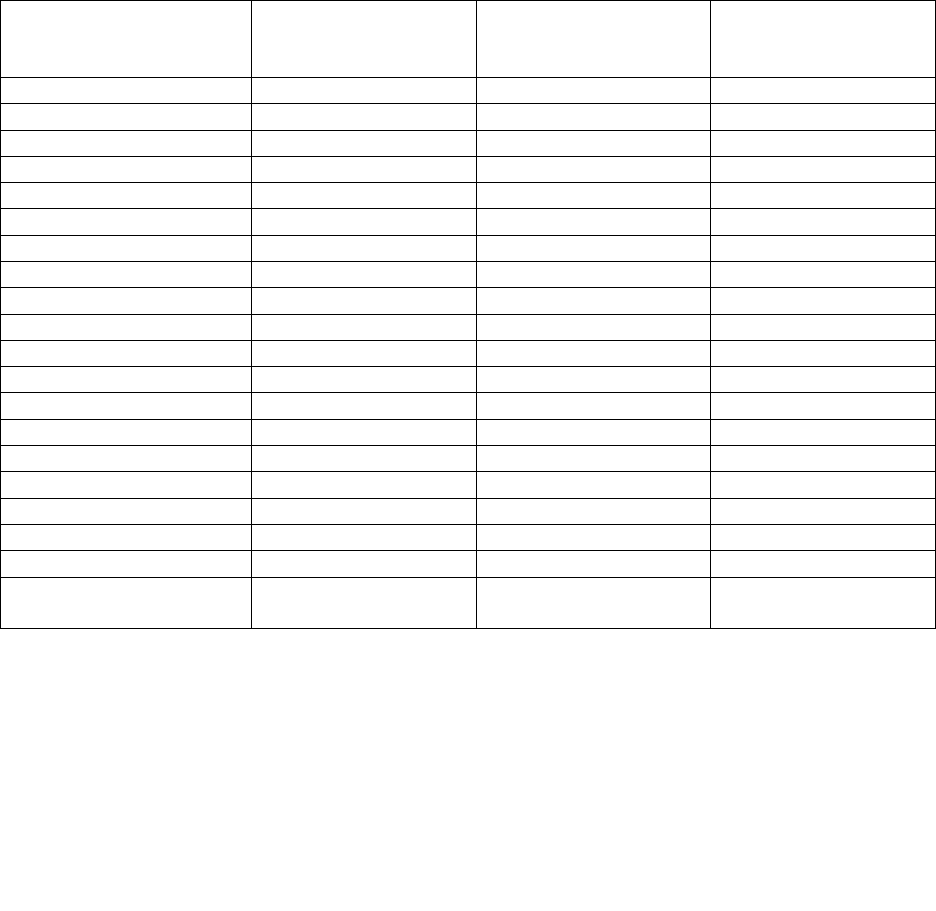
3
This advisory bulletin does not constitute legal advice. Licensees should seek legal counsel to ensure their operations
comply with all applicable laws and administrative rules.
POTENCY
Please refer to R. 420.305 (9) and R. 420.305(3)(a). Laboratories may analyze
additional cannabinoids with approval from the agency based on an acceptable method
validation and successful accreditation from ISO.
The laboratory must analyze a minimum 0.5 gram representative sample of marijuana
product to determine the cannabinoid profile. The laboratory must establish a limit of
quantitation (LOQ) of 1.0 mg/g or lower for all required cannabinoids analyzed and
reported.
RESIDUAL SOLVENTS
The laboratory must analyze a minimum 0.25 gram representative sample to assess the
presence of residual solvents in accordance with their associated action limits (Table 1).
Table 1. Action Limits for Residual Solvents.
Solvent CAS Number Action Limit for
Inhaled Products
(ppm)
Action Limit for
Non-inhaled
Products (ppm)
1,2
-
Dichloroethane
107
-
06
-
2
2
.00
5
.00
Acetone 67-64-1 750 5000
Acetonitrile
75
-
05
-
8
60
.0
410
Benzene 71-43-2 1.00 2.00
Butanes all isomers*
106
-
97
-
8
800
5000
Chloroform
67
-
66
-
3
2
.00
60
.0
Ethanol 64-17-5 1000 5000
Ethyl acetate
141
-
78
-
6
400
5000
Ethyl ether 60-29-7 500 5000
Ethylene oxide
75
-
21
-
8
5
.00
50
.0
Heptane
142
-
82
-
5
500
5000
Hexanes all isomers^
110
-
54
-
3
50
290
Isopropyl alcohol
67
-
63
-
0
500
5000
Methanol 67-56-1 250 3000
Methylene chloride
75
-
09
-
2
125
600
Pentanes all isomers+ 109-66-0 750 5000
Propane
74
-
98
-
6
2100
5000
Trichloroethylene
79
-
01
-
6
25
.0
80
.0
Toluene 108-88-3 150 890
Total xylenes (ortho-,
meta
-
, para
-
)
1330-20-7 150 2170
* Butane isomers include 2-methylpropane or isobutane CAS Number 75-28-5.
+ Pentane isomers include isopentane (methylbutane) CAS Number: 78-78-4 & neopentane (dimethylpropane) CAS Number: 463-
82-1 Y
^ Hexane isomers 2,2-Dimethylbutane CAS Number: 75-83-2, 2,3-Dimethylbutane CAS Number: 79-29-8, 2-Methylpentane CAS
Number: 107-83-5, 3-Methylpentane CAS Number: 96-14-0

4
This advisory bulletin does not constitute legal advice. Licensees should seek legal counsel to ensure their operations
comply with all applicable laws and administrative rules.
HEAVY METALS
The laboratory must analyze a minimum 0.5 gram representative sample of marijuana
products to assess the presence of heavy metals in accordance with their associated
action limits based on a 5 gram/day consumption of marijuana (Table 2).
The LOQ for heavy metals must be ½ the action limit.
Table 2. Heavy Metal Action Limits.
Heavy metal Action Limit for
Inhaled
Marijuana flower
(ppm)
Action Limit for
Inhaled Marijuana
concentrates (ppm)
Action Limit for
other Marijuana
products (ppm)
Lead
1.00 0.500 0.500
Inorganic Arsenic
0.4
00
0.2
00
1.5
00
Mercury
0.200 0.100 3.000
Cadmium
0.4
00
0.2
00
0.5
00
Total Chromium
1.2
00
0.6
00
2.0
00
Nickel*
1.0
00
0.5
00
N/A
Copper*
N/A
3.0
00
+
N/A
+ Copper is required for vaping products only.
FOREIGN MATTER ANALYSIS
The laboratory should perform foreign material testing on not less than 30% of the total
representative sample of intact buds and flower material prior to sample grinding or
milling.
1. The buds should be separated into no less than 10 increments. The results from
which can be averaged together as total foreign matter contamination.
2. Dissection of nodes should be done whenever physically possible.
3. If dissection of distinct nodes is deemed unnecessary, due to the small and compact
nature of the buds (“popcorn” buds), the buds then should be examined in their entirety
and additionally cut in half to observe the inside portion.
4. In the case of marijuana trim, kief, concentrate or infused product, the calculation to
determine 30% of the sampling batch should be included in the SOP.
5. Quantitation of filth should be done as a total surface area calculation. The
laboratory-derived calculation should be included in the SOP.
6. If a sample fails for foreign matter, the laboratory should include a note in Metrc
listing all contaminants identified.
When the laboratory performs foreign material testing, the laboratory must do all of the
following:

5
This advisory bulletin does not constitute legal advice. Licensees should seek legal counsel to ensure their operations
comply with all applicable laws and administrative rules.
1. Develop a procedure and associated training documents for the identification of
powdery mildew, pests, mold and other foreign material which requires agency
approval before testing. The training document must include a reference text for
common cannabis contaminants.
2. Examine both the exterior and interior of the sample. Samples must be viewed
on both high and low power magnifications. Pests and other foreign
contaminants typically do not sit on the outside of the material and will require the
technician to dissect the material while viewing under a microscope.
3. All quantitation must be done on high power magnification and the laboratory
must develop a grading scale which clearly dictates a failed sample.
Example grading scale for pests:
0-2 pests per HPF(high power field) = mild
2-4 pests per HPF= moderate
4+ pests per HPF= severe
All samples graded as severe are automatic failures.
4. All failures should be documented photographically.
Analysis for Organic Matter
The action limit for crude marijuana is not more than 5.0% of stems and not more than
2.0% of other foreign matter. All failures should be documented photographically. It is
recommended that the laboratory clearly delineate calculation guidelines and ranges for
total surface area contamination. Foreign matter analysis should be performed prior to
all other testing, aside from microbials. The material remaining after foreign matter
analysis is acceptable for all chemical testing but should not be used for microbial
testing. The amount of marijuana or marijuana product used for testing should be no
less than 30% of the total gram weight or total sample lot obtained for compliance
testing.
In the case of marijuana flower, the allotted 30% should come from separate, intact
buds.
1. The buds should be separated into no less than 10 increments. The results
from which can be averaged together as total foreign matter contamination.
2. Dissection of nodes should be done whenever physically possible.
3. If dissection of distinct nodes is deemed unnecessary, due to the small and
compact nature of the buds (“popcorn” buds), the buds then should be examined
in their entirety and additionally cut in half to observe the inside portion.
4. In the case of marijuana trim, kief, concentrate or infused product, the
calculation to determine 30% of the sampling batch should be included in the
SOP.
5. Filth analysis should be performed at a low-power magnification.
6. Quantitation of filth should be done as a total surface area calculation. The
laboratory-derived calculation should be included in the SOP.
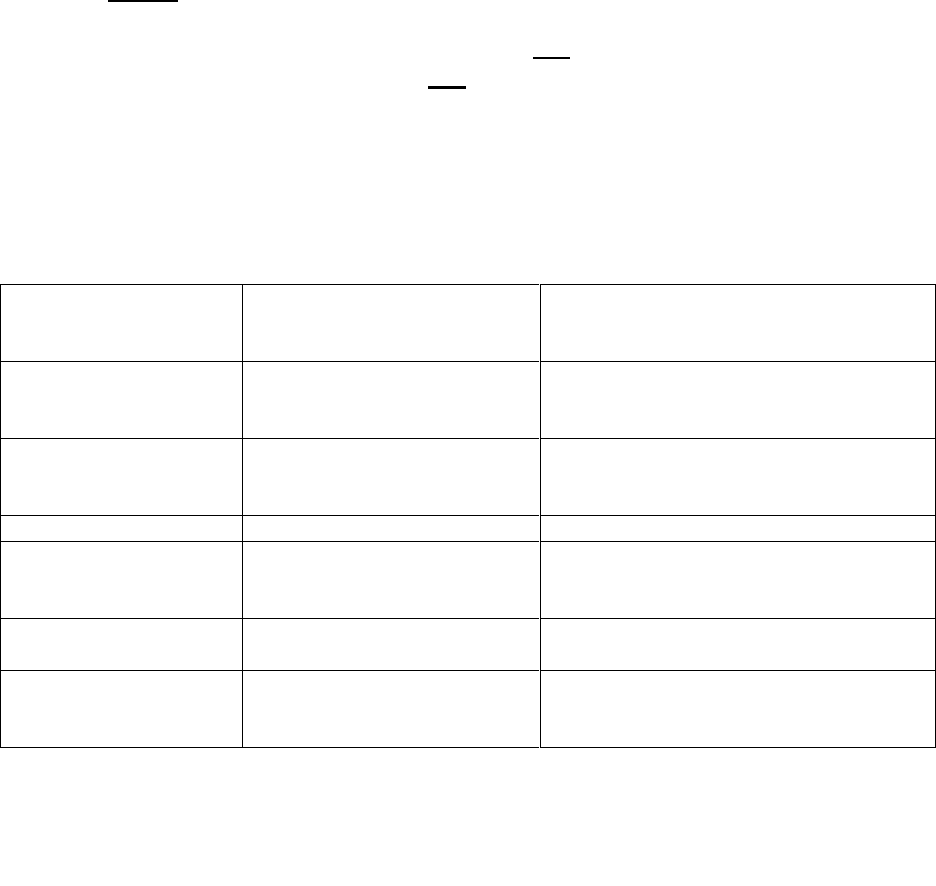
6
This advisory bulletin does not constitute legal advice. Licensees should seek legal counsel to ensure their operations
comply with all applicable laws and administrative rules.
7. If a sample fails for foreign matter, the laboratory should include a note in
Metrc listing all contaminants identified.
Analysis for Inorganic Matter
For these purposes, inorganic matter includes, but is not limited to, any material that
would not normally be found on a living organism (plant) and includes materials such as
glass, metal shavings, or synthetic fibers. In this case, the presence of any inorganic
matter on any marijuana plant, concentrate, or infused product would result in an
automatic failure for foreign matter. The observed matter should be documented in the
results note included in Metrc.
WATER ACTIVITY (a
w
)
A marijuana sample passes water activity testing if the water activity does not
exceed 0.65 a
w
.
An edible marijuana-infused product passes water activity testing if the water
activity does not exceed 0.85 a
w
.
Non-edible marijuana-infused products are not subject to water activity testing.
Marijuana infused beverages are not subject to water activity testing with
approval from the agency.
MICROBIALS
Any detection that exceeds the published action limit is considered a failure based on
the criteria for acceptability (Table 3).
Table 3. Microbial Screening Action Limits (CFU/g).
Bud, shake/trim, and kief
from Harvest Batch
(CFU/g)
Marijuana-Infused Product (CFU/g)
Medical
Total Yeast & Mold
Count
10,000 10,000
Adult-Use
Total Yeast & Mold
Count
100,000 10,000
Total Coliform
1000 100
Shiga toxin-
producing E. coli
(STEC)
Not detected in 1 gram Not detected in 1 gram
Pathogenic
Salmonella spp.
Not detected in 1 gram Not detected in 1 gram
Aspergillus flavus,
fumigatus, niger &
terreus
Not detected in 1 gram Not detected in 1 gram

7
This advisory bulletin does not constitute legal advice. Licensees should seek legal counsel to ensure their operations
comply with all applicable laws and administrative rules.
CHEMICAL RESIDUE
Rule 5(11) in the Marihuana Sampling and Testing Rule Set R 420.305 (11)
For chemical residue and target analyte testing, the agency shall publish a list of
quantification levels. Any result that exceeds the action limit is a failed sample.
The laboratory must analyze a minimum 0.5-gram representative sample for analysis of
chemical residues.
Table 4. List of Banned Chemical Ingredients: Action Limit and LOQ
[11]
.
Analytes
CAS Number
Action Limit (ppm)
LOQ (ppm)
Abamectin 71751-41-2 0.5 0.25
Acephate
30560
-
19
-
1
0.4
0.2
Acequinocyl 57960-19-7 2 1
Acetamiprid
135410
-
20
-
7
0.2
0.1
Aldicarb 116-06-3 0.4 0.2
Azoxystrobin
131860
-
33
-
8
0.2
0.1
Bifenazate
149877
-
41
-
8
0.2
0.1
Bifenthrin 82657-04-3 0.2 0.1
Boscalid
188425
-
85
-
6
0.4
0.2
Carbaryl 63-25-2 0.2 0.1
Carbofuran
1563
-
66
-
2
0.2
0.1
Chlorantraniliprole 500008-45-7 0.2 0.1
Chlorfenapyr
122453
-
73
-
0
1
0.5
Chlorpyrifos
2921
-
88
-
2
0.2
0.1
Clofentezine 74115-24-5 0.2 0.1
Cyfluthrin
68359
-
37
-
5
1
0.5
Cypermethrin 52315-07-8 1 0.5
Daminozide
1596
-
84
-
5
1
0.5
DDVP (Dichlorvos) 62-73-7 1 0.5
Diazinon
333
-
41
-
5
0.2
0.1
Dimethoate
60
-
51
-
5
0.2
0.1
Ethoprophos 13194-48-4 0.2 0.1
Etofenprox
80844
-
07
-
1
0.4
0.2
Etoxazole 153233-91-1 0.2 0.1
Fenoxycarb
72490
-
01
-
8
0.2
0.1
Fenpyroximate 134098-61-6 0.4 0.2
Fipronil
120068
-
37
-
3
0.4
0.2
Flonicamid
158062
-
67
-
0
1
0.5
Fludioxonil 131341-86-1 0.4 0.2
Hexythiazox
78587
-
05
-
0
1
0.5
Imazalil 35554-44-0 0.2 0.1
Imidacloprid
138261
-
41
-
3
0.4
0.2
Kresoxim-methyl 143390-89-0 0.4 0.2
Malathion
121
-
75
-
5
0.2
0.1
Metalaxyl
57837
-
19
-
1
0.2
0.1
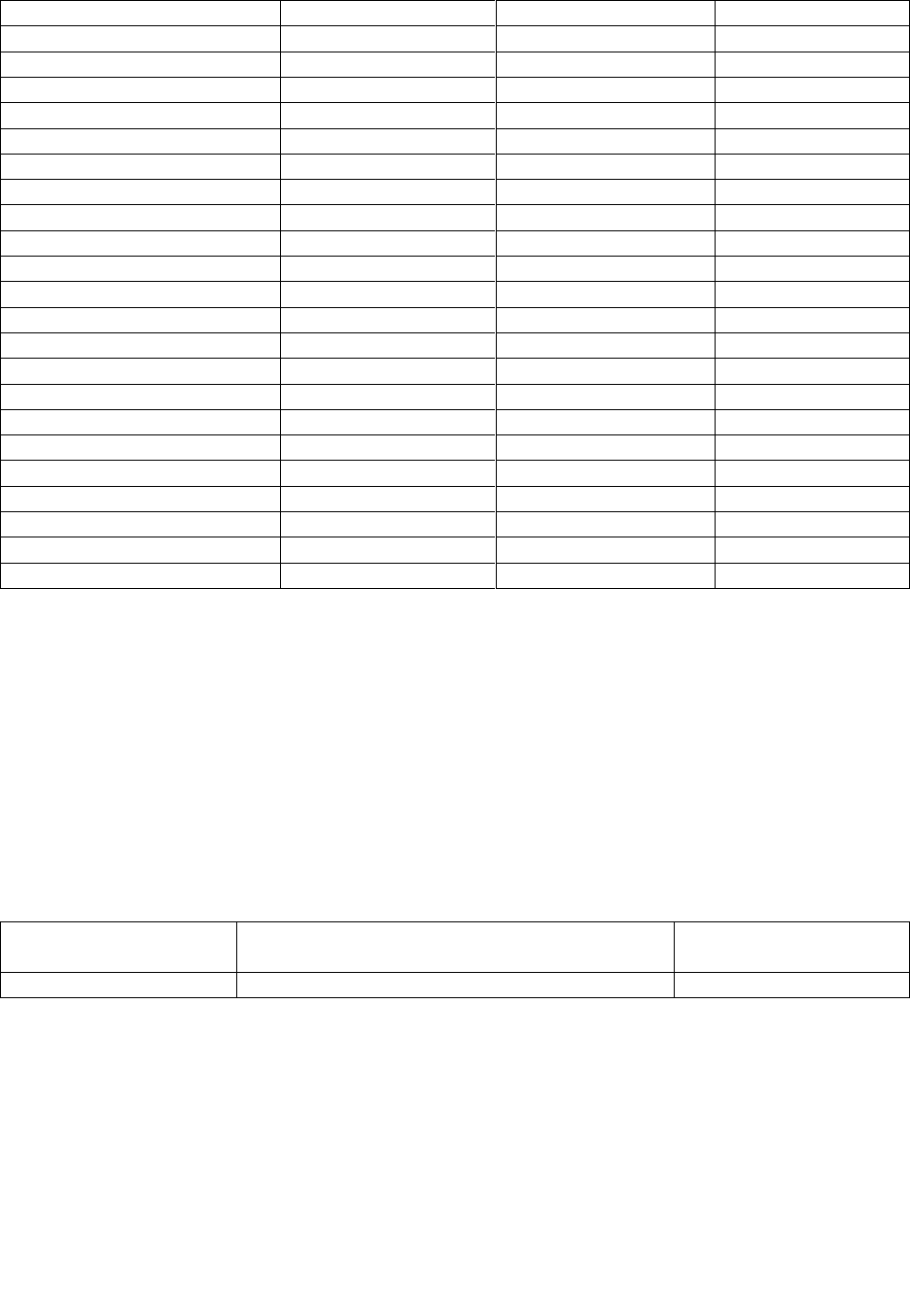
8
This advisory bulletin does not constitute legal advice. Licensees should seek legal counsel to ensure their operations
comply with all applicable laws and administrative rules.
Methiocarb 2032-65-7 0.2 0.1
Methomyl
16752
-
77
-
5
0.4
0.2
Methyl parathion 298-00-0 0.2 0.1
MGK
-
264
113
-
48
-
4
0.2
0.1
Myclobutanil 88671-89-0 0.2 0.1
Naled
300
-
76
-
5
0.5
0.25
Oxamyl
23135
-
22
-
0
1
0.5
Paclobutrazol 76738-62-0 0.4 0.2
Permethrins*
52645
-
53
-
1
0.2
0.1
Prallethrin 23031-36-9 0.2 0.1
Phosmet
732
-
11
-
6
0.2
0.1
Propiconazole 60207-90-1 0.4 0.2
Propoxur
114
-
26
-
1
0.2
0.1
Pyridaben
96489
-
71
-
3
0.2
0.1
Pyrethrins+ 8003-34-7 1 0.5
Spinosad
168316
-
95
-
8
0.2
0.1
Spiromesifen 283594-90-1 0.2 0.1
Spirotetramat
203313
-
25
-
1
0.2
0.1
Spiroxamine
118134
-
30
-
8
0.4
0.2
Tebuconazole
80443
-
41
-
0
0.4
0.2
Thiacloprid
111988
-
49
-
9
0.2
0.1
Thiamethoxam 153719-23-4 0.2 0.1
Trifloxystrobin
141517
-
21
-
7
0.2
0.1
* Permethrins should be measured as cumulative residue of cis- and trans-permethrin isomers (CAS numbers 54774-
45-7 and 51877-74-8).
+ Pyrethrins should be measured as the cumulative residues of pyrethrin 1, cinerin 1 and jasmolin 1 (CAS
numbers121-21-1, 25402-06-6, and 4466-14-2 respectively)
TARGET ANALYTES
“Target Analyte” is defined as non-marihuana inactive ingredient designated for
analysis.
Vitamin E Acetate has been identified as a target analyte by the CRA. All vape
cartridges must be tested for Vitamin E Acetate.
Table 5. Target Analytes for Marihuana Products Intended for Inhalation.
Target Analyte (CAS) Number
LOQ (ppm)
Vitamin E
Acetate
58
-
95
-
7
100
MYCOTOXINS
Rule (3) in the Marihuana Sampling and Testing Rule Set R 420.306 (3)
Products that failed testing for Aspergillus may be remediated after subsequent testing
for mycotoxins in accordance with R 420.305(3)(h).
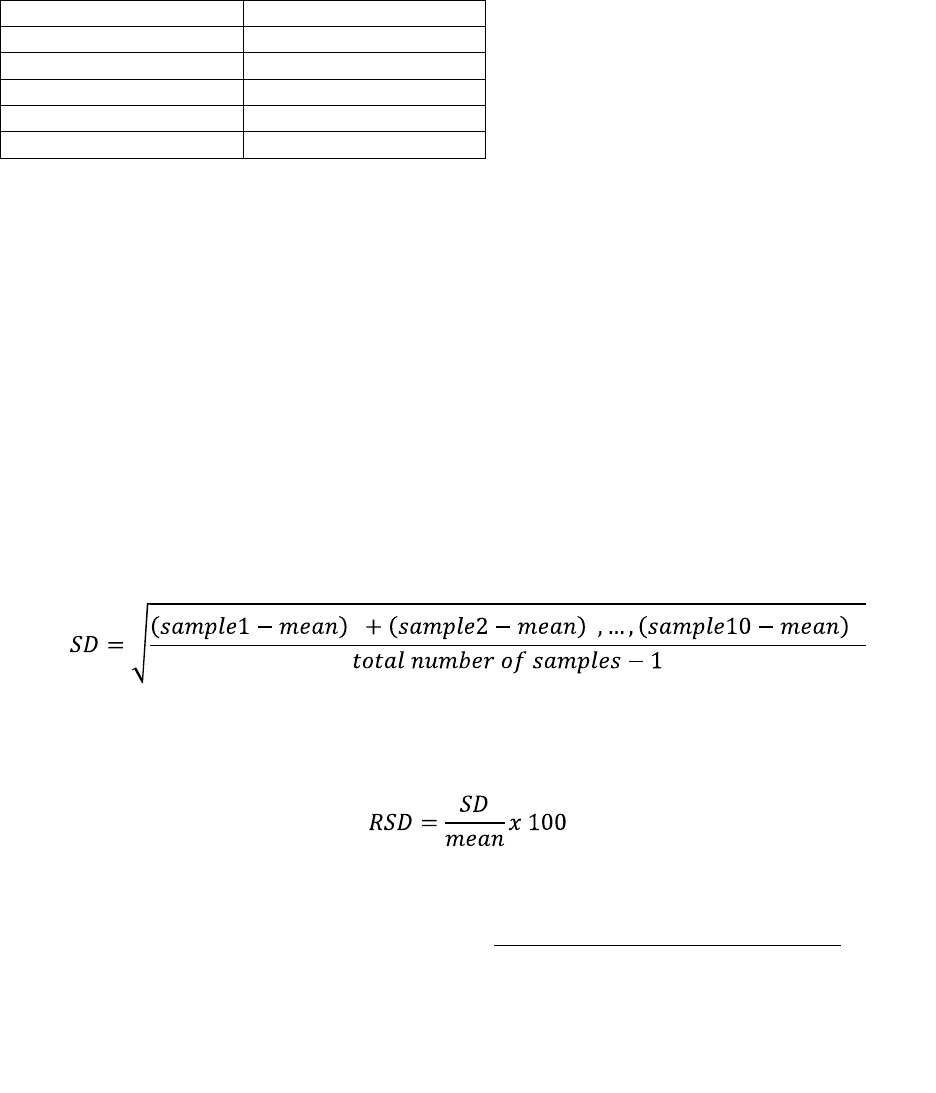
9
This advisory bulletin does not constitute legal advice. Licensees should seek legal counsel to ensure their operations
comply with all applicable laws and administrative rules.
The laboratory must analyze a minimum 0.5-gram representative sample for analysis of
mycotoxins.
Rule (20) in the Marihuana Sampling and Testing Rule Set R 420.305 (20)
The agency may request mycotoxin testing. A marihuana sample with a value that
exceeds the published acceptable level is a failed sample. A marihuana sample that is
below the acceptable value is a passing sample.
Table 6. List of Required Mycotoxins and Accepted Detection Limits.
Mycotoxin
PPB
Aflatoxin B1
<20
Aflatoxin B2
<20
Aflatoxin G1 <20
Aflatoxin G2
<20
Ochratoxin A <20
HOMOGENEITY
Homogeneity testing or the process of homogeneous sampling, is when all items in a
sample are chosen at random to be representative of product batch so they have similar
or identical traits. To perform homogeneity testing each dose or serving must be
treated as a separate individual sample and a total of 10 doses or servings must
be sampled at random. The weight and concentration of Delta-9 THC must be
recorded and the variability of weight and concentration of Delta-9 THC among servings
in a single package must not exceed +/- 15%.
This can be determined by first calculating the Standard Deviation (SD) among samples
and subsequently calculating the Relative Standard Deviation (RSD) for both weight
and concentration of Delta-9 THC.
The SD is calculated using the following formula:
2 2 2
The RSD is calculated using the following formula:
The CRA has determined that the laboratories should complete potency testing based
on the information provided by the processors at the time of the sampling event. If a
product is sampled as an individual serving/dosage, the facility will report total THC by

10
This advisory bulletin does not constitute legal advice. Licensees should seek legal counsel to ensure their operations
comply with all applicable laws and administrative rules.
serving/dose. If the product is sampled in final form, total THC content for the package
will be reported.
It is not incumbent on the laboratory to determine if the product will meet the package
labeling requirements. The laboratory testing results provided on the package will report
the calculated THC as the product was submitted for testing and is not required to
replicate the processor designated package label for THC content. The processor
designated package label will be considered the target THC.
pH
pH is a quantitative measure of the acidity or basicity of aqueous or other liquid solution
and is a required test for marijuana infused beverages. Any laboratory seeking approval
to test marijuana infused beverages must follow AOAC Method 945.10 and should
conduct analyses and validations in accordance with all manufacturer specifications.

11
This advisory bulletin does not constitute legal advice. Licensees should seek legal counsel to ensure their operations
comply with all applicable laws and administrative rules.
Table 7. Marijuana Testing Requirements.
a
Extraction using ice water, rosin press or dry ice
b
Not required for non-edible marijuana product or beverages with CRA approval.
c
Moonrock, Caviar joint, infused pre-roll, tarantula etc.
Raw Plant
Material
Non-Solvent
Concentrate
a
Inhalable
Concentrate
(Solvent based)
Vape
Concentrate
Inhalable
Compound
Concentrate
Products
c
Marijuana-
Infused
Product
Vitamin E
Acetate
√
Homogeneity √
Potency
Analysis
√ √ √ √ √ √
Foreign Matter
Inspection
√ √ √ √
Microbial
Screen
√ √
√ √
Water Activity √
√ √
b
Heavy Metal
Screen
√ √ √ √ √ √
Residual
Solvents
√ √ √ √
Chemical
Residue
Analysis
√ √ √ √ √ √

12
This advisory bulletin does not constitute legal advice. Licensees should seek legal counsel to ensure their operations
comply with all applicable laws and administrative rules.
RECOMMENDATIONS FOR QUALITY CONTROL
Rule (5)(b) in the Marihuana Sampling and Testing Rule Set R 420.305b(5) A laboratory
must prepare a written description of its quality control activities, included as part of a
quality control manual.
All of the following items should be addressed in the quality control manual:
(a) Daily, weekly, monthly, and annual requirements.
(b) An analytical testing batch.
(c) All analytical testing runs must be bracketed with quality controls.
(6) Method specific quality control acceptance criteria, which must be followed.
RECOMMENDATIONS
Analytical Batch
Should be clearly defined as every 20 samples.
Laboratory Reagent Blank
Checks for background contamination should be the first sample of the analytical
run; a blank should also be run before and after a calibration check (CC), initial
calibration verification (ICV) /continuing calibration verification (CCV) and at the
end of the run.
ICV/CCV
Initial Calibration Verification (ICV) – the ICV is performed by analyzing a test
solution of known analyte concentration(s) after calibration, but before sample
testing on the initial day of the calibration. The ICV should be a standard that is
not from the same vendor/lot that is used for the calibration curve.
Continuing Calibration Verification (CCV) – the CCV is performed by analyzing a
test solution of known analyte concentration(s) prior to sample testing on each
testing day and continued periodically during the analytical batch run, no less
frequently than once after each set of 20 samples. The CCV should be a
standard that is not from the same vendor/lot that is used for the calibration curve
IF calibration is maintained for more than one week.
Laboratory Fortified Matrix (LFM) / Laboratory Fortified Matrix
Duplicate (LFMD)
Analyze a sample with a known amount of standard added (spike).
For the LFMD, spike the same sample a second time (duplicate).

13
This advisory bulletin does not constitute legal advice. Licensees should seek legal counsel to ensure their operations
comply with all applicable laws and administrative rules.
Calculate Relative Percent Difference (RPD) between spiked sample and spiked
duplicate, target value should be close to the first value and have a small RPD
(less than 20%).
Spike volume should be less than 1% of the volume. Example: spike with 1 mL of
1000 mg/L into 100 mL sample will equal a 10 mg/L increase in concentration.
Duplicate
Analyze the same sample twice, this must be two separate preparations. The
sample should be chosen at random and run together on the same analytical run.
Calculate the relative percent difference (RPD) between first sample and
replicate, target value should be close to the first value and have a small RPD
(less than 20%).
Variability may be introduced during sample preparation. To account for this, if
more than one staff member is prepping samples, a sample duplicate for each
set of prepared samples must be run.
All validated approved methods have been demonstrated to be precise, therefore
laboratories are NOT permitted to run samples in duplicate and average the
results.
ANNUAL REQUIREMENTS
Demonstration of Capability (DOC)
Each analyst must have a DOC which includes documentation that they can
accurately run each test.
Documentation that an analyst has read and understands all appropriate SOPs
and methods.
Backup analysts should do this once a year or any time there is a reason to
question competence.
Competency assessments should be completed not less than annually including
having staff run a previously reported sample from sample preparation through
result reporting to assure all staff are following the written SOPs.
Method Detection Limit (MDL)
Run at least seven samples at low levels following procedure outlined below, i.e.,
daily requirements.
Corrective Action
Corrective actions must be included in the SOPs for each method and should
include what to do if QC tests fail or are out of range. For example, if standards
fail, then recalibrate and run test again.

14
This advisory bulletin does not constitute legal advice. Licensees should seek legal counsel to ensure their operations
comply with all applicable laws and administrative rules.
QC Acceptance
Include in the SOP for each method the acceptance ranges for standards,
duplicates, spikes, etc., and verify that they match the method requirements.
QC ACCEPTANCE CRITERIA*
*unless otherwise specified in reference method.
LRB < MDL
ICV/CCV ± 10%
LFM/LFMD ± 20%
RPD < 20%
Reporting limit = MDL Calculations
% Recovery for LFB = LFB Result x 100%
Expected Concentration
RPD – relative percent differences for duplicates and LFM/LFMD
RPD = (|Num1-Num2| / ((Num1+Num2) / 2)) x 100
Where:
Num1= Original Number
Num2= Second Number
% Recovery for LFM – when using less than or equal to 1% spike volume compared to sample
volume
% Recovery = LFM Result – Sample Result X 100%
DEFINITIONS
A variety of definitions relating to detection limits and quantitation limits are published in
reference literature and by government agencies, however, universally accepted
procedures for calculating these limits do not exist. The definitions below attempt to
clarify the meaning of these terms as recognized by the CRA.
[13]
Analytical batch size: An analytical batch is defined as 20 samples excluding QC.
Calibration check (CC): Should be analyzed prior to sample analysis and every 10
– 20 samples thereafter (or after a 12-hour period, should less than 20 samples be
analyzed). The CCV controls are generally created from the same source as the
calibration material. The laboratory must outline acceptance criteria as relevant to the
method; ideally, the CCV should fall within at least ± 15% of the spike value.

15
This advisory bulletin does not constitute legal advice. Licensees should seek legal counsel to ensure their operations
comply with all applicable laws and administrative rules.
Calibration requirements: Calibration must occur not less than monthly. At the
beginning of each day samples are to be analyzed, a calibration curve composed of four
or more points including all target analytes should be generated according to the
approved SOP. Where the determinative time is extensive and the instrument is stable,
the calibration curve should be initially developed; thereafter, each day that samples are
to be analyzed, this curve should be verified by analysis of a calibration check (CC)
following the requirements listed below. The check must be +/- 10% of the known value.
Continuing calibration verification (CCV): This verification should be done at
both the beginning and end of the analyses, including at least one standard for each of
the target analytes at the expected concentration range. It is recommended that a
calibration standard of one component of a multicomponent analyte also be analyzed
each day or work shift. All checks must be within 10% of the known value or the
instrument is to be recalibrated as specified in the calibration requirements.
Demonstration of capability (DOC): Each analyst should be assigned a file in
which records are maintained that demonstrate the capability of the individual to
perform analyses for which they are responsible on frequent or infrequent basis. At a
minimum, the analyst should calibrate and analyze four standards to demonstrate their
ability to run each test. Additionally, the file should contain documentation (signed form)
that the analyst has read and understands all assigned SOPs and methods. Backup
analysts should do this once a year. The primary analyst should recalculate DOCs when
a change in the method, analyst, or instrument is made which could affect precision,
accuracy, or sensitivity. Minor changes in methodology should prompt a check to verify
that the precision, accuracy, and sensitivity have been maintained.
Initial demonstration of capability (IDOC): Before beginning the analysis of
samples, an IDOC must be performed. The IDOC includes a demonstration of the ability
to achieve a low background, the precision and accuracy required by the method, and
determination of the limit of detection (LOD) (see below). An IDOC should be performed
for each instrument. It is also recommended that an IDOC be performed by each
analyst. In addition, it is recommended that the IDOC also addresses the variability
introduced if more than one sample preparation analyst is used. Precision, accuracy,
and LOD should be comparable for each technician.
Laboratory fortified sample matrix: Laboratory fortified sample matrix
requirements stated in the methods must be met. If there are no laboratory fortified
sample matrix requirements in the method, the following guidelines are to be used: The
laboratory should add a known quantity of analyte(s) to a percentage (to be described in
the approved SOP) of the routine samples to determine sample matrix interference; the
fortified concentration should not be less than the concentration of the sample selected
for fortification unless specified by the method; if the sample concentration is unknown
or less than detectable, the analyst should choose an appropriate concentration (e.g., a
percentage of the published action limit or mid-point in the calibration range); over time,
samples from all routine sources should be fortified; the procedure should be described
in the SOP; if any of these checks are not within the criteria specified in the method or
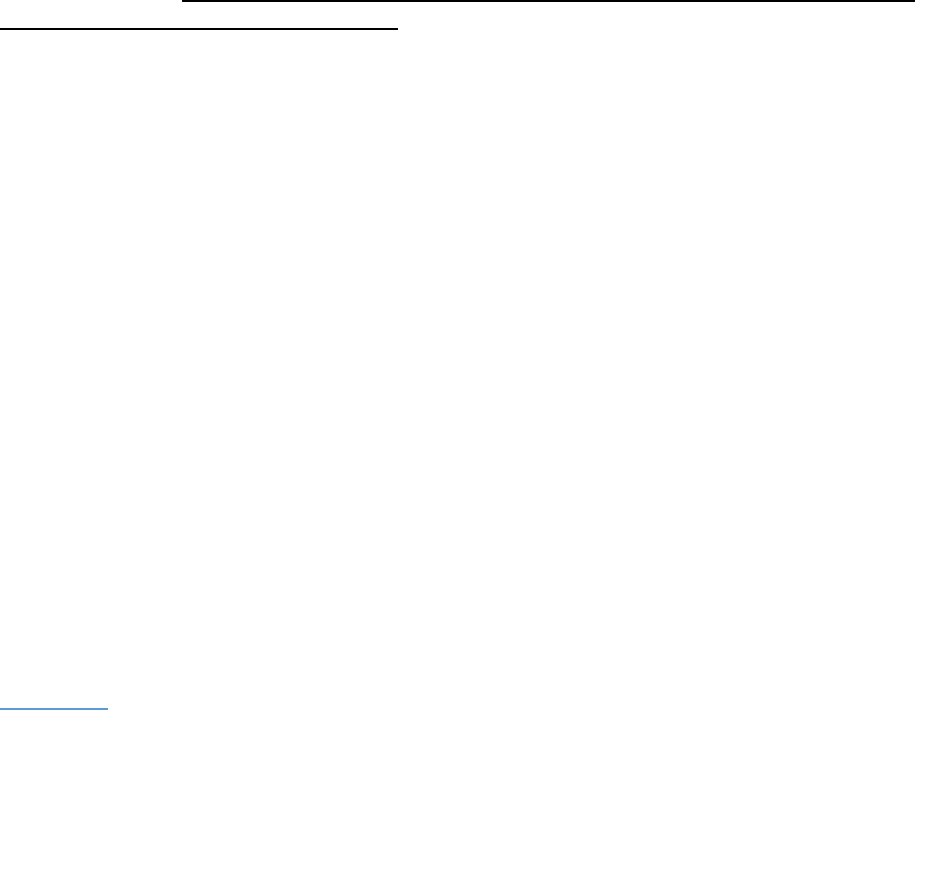
16
This advisory bulletin does not constitute legal advice. Licensees should seek legal counsel to ensure their operations
comply with all applicable laws and administrative rules.
control limits specified in this document, and the laboratory performance is in control,
the result for that sample should be flagged to inform the data user that the results are
suspect due to matrix effects.
Laboratory reagent blank (LRB): An LRB should be carried through the full
analytical procedure with every sample batch. In general, results from LRBs should not
exceed the laboratory's minimum reporting limit (MRL), the lowest concentration of
standard used for quantitation.
Limit of detection (LOD) or detection limit:
The lowest concentration level that
can be determined to be statistically different from a blank (99% confidence). The LOD
is typically determined to be in the region where the signal to noise ratio is greater than
five. Limits of detection are matrix, method, and analyte specific. The LOD is
approximately equal to the MDL for those tests which the MDL can be calculated.
Limit of quantitation (LOQ): The minimum concentration or mass of an analyte in
a target matrix that can be reported as a quantitative result. For all analyses aside from
Target Analytes, the LOQ must be at a minimum 1/2 of the published action limit when
the LOQ is not specified in the SMPR. The analyst should determine LOQs when any
change is made which could affect the LOQs, or more frequently if required by the
method. In addition, the analyst must demonstrate low-level capability on an ongoing
basis through an LOQ determination or repeated low-level analyses.
Linear calibration range (LCR): The region of a calibration curve within which a
plot of the concentration versus the response of a particular analyte remains linear, and
the correlation coefficient of the line is approximately 1 (0.995 for most analytes). The
plot may be normal-normal, log-normal, or log-log when allowed by the analytical
method.
Low level quantitation: The laboratory's minimum reporting limits (MRL) should be
reported to the client along with the data. The reporting limit must be below the CRA’s
published action limits. Laboratories should run an LFB at their MRL every analysis day
and should not report contaminants at levels less than the level at which they routinely
analyze their lowest standard.
Method detection limit (MDL): The minimum concentration of a substance that
can be measured and reported with 99% confidence that the analyte concentration is
greater than zero and is determined from analysis of a sample in a target matrix
containing the analyte. The MDL procedure is designed to be a straightforward
technique for estimation of the detection limit for a broad variety of physical and
chemical methods. The procedure requires a complete, specific, and well-defined
analytical method. It is essential that all sample processing steps used by the laboratory
be included in the determination of the MDL. To calculate MDLs, please follow this
procedure.

17
This advisory bulletin does not constitute legal advice. Licensees should seek legal counsel to ensure their operations
comply with all applicable laws and administrative rules.
REFERENCES
Aldous, K., Applen, J., Fan, Z., Fox, M., Kassner, S., Latshaw, M., & Verbrugge, D. (2016). Guidance for
State Medical Cannabis Testing Programs. Association of Public Health Laboratories.
[1]
AOAC. Official Methods of Analysis 991.14. 1994. Coliform and Escherichia coli counts in foods. AOAC.
Intl.
[2]
AOAC. Official Methods of Analysis 997.02. 2002. Yeast and mold counts in foods. AOAC. Intl.
[3]
ASTM D8196-18, Standard practice for determination of water activity (aw) in cannabis flower, ASTM
International, West Conshohocken, PA, 2018.
[4]
Audino, S., Acevedo, B., Angerhofer, M., Astill, T., Atkins, P., Aubin, A., & Brown, A. N. Standard Method
Performance Requirements (SMPRs®) 2018.011: Identification and quantitation of selected pesticide
residues in dried cannabis materials.
[5]
Audino, S., Angerhofer, M., Atkins, P., Brauninger, R. M., Brown, P. N., Burdette, C. Q., & Gibson, P.
(2017). AOAC SMPR® 2017.002. Journal of AOAC International, 100(4), 1204-1207.
[6]
Brabcová, I., Kovářová, L., Šatínský, D., Havlíková, L., & Solich, P. (2013). A fast HPLC method for
determination of vitamin E acetate in dietary supplements using monolithic column. Food analytical
methods, 6(2), 380-385.
[7]
Das, P., Kumar, S. R., & Maity, A. Risk based approach to evaluate the safety, risk and control of
Elemental Impurities in Pharmaceutical Drug Products
[8]
De Backer, B., Debrus, B., Lebrun, P., Theunis, L., Dubois, N., Decock, L., & Charlier, C. (2009).
Innovative development and validation of an HPLC/DAD method for the qualitative and quantitative
determination of major cannabinoids in cannabis plant material. Journal of Chromatography B, 877(32),
4115-4124.
[9]
EPA, U. (1995). Method 3052: microwave assisted acid digestion of siliceous and organically based
matrices. Test Methods for Evaluating Solid Waste.
[10]
Farrer, D. G. (2016). Technical Report: Oregon Health Authority's Process to Determine which Types of
Contaminants to test for in Cannabis Products, and Levels for Action. Oregon Health Authority, Public
Health Division.
[11]
Freeman, K., McHenry, M., Cats-Baril, W., & Grace, T. (2016). Cannabis Testing for Public Safety-Best
Practices for Vermont Analytical Laboratories. PhytoScience Institute.
[12]
Guidance, A. D. L. (1996). Laboratory Guide for Determining Method Detection Limits. Wisconsin
Department of Natural Resources Laboratory Certification Program April.
[13]
Guideline, I. H. T. (2005). Impurities: Guideline for residual solvents Q3C (R5). Current Step, 4, 1-25.
[14]
Guideline, I. H. (2018). Guideline for elemental impurities Q3D (R1).
[15]
International Conference on Harmonization. (2003). Q1A (R2), Stability testing of new drug substances
and products. In International Conference on Harmonization. Geneva: International Conference on
Harmonization.
[16]
Kagen, S. L., Kurup, V. P., Sohnle, P. G., & Fink, J. N. (1983). Marijuana smoking and fungal
sensitization. Journal of allergy and clinical immunology, 71(4), 389-393.
[17]

18
This advisory bulletin does not constitute legal advice. Licensees should seek legal counsel to ensure their operations
comply with all applicable laws and administrative rules.
Kilmer, B., Caulkins, J. P., Midgette, G., Dahlkemper, L., MacCoun, R. J., & Liccardo, P. R. (2013). Before
the grand opening: Measuring Washington State’s marijuana market in the last year before legalized
commercial sales. Rand Corporation.
[18]
Kowalcyk, B., McLellan, M. R., Goldman, L., Goldman, D., Holmes, H. T., & Weaver, C. (2016). Office of
Regulatory Affairs Strategies for Building an Integrated National Laboratory Network for Food and Feed.
[19]
Lehotay, S. (2007). AOAC Official Method 2007.01 Pesticide residues in foods by acetonitrile extraction
and partitioning with magnesium sulfate. Journal of AOAC International, 90(2), 485-520.
[20]
Light, M. K., Orens, A., Lewandowski, B., & Pickton, T. (2015). Market size and demand for marijuana in
Colorado. Marijuana Policy Group.
[21]
Ma, C., Oketch-Rabah, H., Kim, N. C., Monagas, M., Bzhelyansky, A., Sarma, N., & Giancaspro, G.
(2018). Quality specifications for articles of botanical origin from the United States Pharmacopeia.
Phytomedicine, 45, 105-119.
[22]
McPartland, J. M., & McKernan, K. J. (2017). Contaminants of concern in cannabis: Microbes, heavy
metals and pesticides. In Cannabis sativa L.-Botany and Biotechnology (pp. 457-474). Springer, Cham.
[23]
Osterbauer, N., Krepps, S., Sackett, J., Holladay, C., Wendt, E., Wells, D., & Kristof, J. Protocol for
Collecting Samples of Usable Marijuana. ORELAP-SOP-001 Rev. 3.0. 2016 December.
[24]
Patel, B., Wene, D., & Fan, Z. T. (2017). Qualitative and quantitative measurement of cannabinoids in
cannabis using modified HPLC/DAD method. Journal of pharmaceutical and biomedical analysis, 146,
15-23.
[25]
Pharm, E., & Lipomed, A. G. (2017). AOAC SMPR® 2017.001.
[26]
Raber, J. C., Elzinga, S., & Kaplan, C. (2015). Understanding dabs: contamination concerns of cannabis
concentrates and cannabinoid transfer during the act of dabbing. The Journal of toxicological sciences,
40(6), 797-803.
[27]
Sexton, M., & Ziskind, J. (2013). Sampling cannabis for analytical purposes. BOTEC Analysis Corp, 26.
[28]
Thiex, N. J., & Ramsey, C. A. (2016). Taking and Testing GOODSamples: A Systematic Approach for
Representative Sampling from Field to Test Portion. Journal of Regulatory Science, 4(2), 1-8.
[29]
Thomas, R. (2018). Measuring Elemental Impurities in Pharmaceuticals: A Practical Guide. CRC Press.
[30]
Tchounwou, P. B., Yedjou, C. G., Patlolla, A. K., & Sutton, D. J. (2012). Heavy metal toxicity and the
environment. In Molecular, clinical and environmental toxicology (pp. 133-164). Springer, Basel.
[31]
Upton, R., & ElSohly, M. (Eds.). (2014). Cannabis Inflorescence: Cannabis spp.; Standards of Identity,
Analysis, and Quality Control. American Herbal Pharmacopoeia.
[32]
Unger, P., Brauninger, R., Hudalla, C., Holmes, M., & Sherman, B. (2014). Standards for Cannabis
Testing Laboratories. Eugene, OR: Cannabis Safety Institute. Retrieved, 4(01), 2016.
[33]
United States Pharmacopoeia. (2009). USP< 61> Microbiological examination of nonsterile products:
Microbial enumeration tests. In USP Pharmacists’ Pharmacopeia; United States Pharmacopeial
Convention: Rockville, MD: United States Pharmacopeial Convention. (p. S3).
[34]

19
This advisory bulletin does not constitute legal advice. Licensees should seek legal counsel to ensure their operations
comply with all applicable laws and administrative rules.
United States. Environmental Protection Agency. Office of Ground Water, & Drinking Water. Technical
Support Center. (1997). Manual for the Certification of Laboratories Analyzing Drinking Water: Criteria
and Procedures, Quality Assurance. US Environmental Protection Agency, Office of Water, Office of
Ground Water and Drinking Water, Technical Support Center.
[35]
United States Pharmacopoeia. (2009). USP< 62> Microbiological examination of non-sterile products:
tests for specified microorganisms. Rockville, MD: United States Pharmacopeial Convention.
[36]
United States Pharmacopoeia. (2012). USP< 467> Residual solvents. Rockville, MD: United States
Pharmacopeial Convention.
[37]
Voelker, R., & Holmes, M. (2015). Pesticide use on cannabis. Cannabis Safety Institute, 1-19.
[38]
Ziobro, G. C. (1996). Filth and extraneous materials in foods and drugs. Journal of AOAC International,
79(1), 252-253.
[39]
